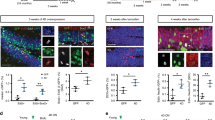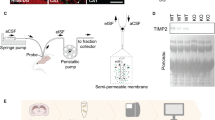Abstract
Neurodegenerative diseases of the central nervous system are often associated with impaired learning and memory, eventually leading to dementia. An important aspect in pre-clinical research is the exploration of strategies to re-establish learning ability and access to long-term memories. By using a mouse model that allows temporally and spatially restricted induction of neuronal loss, we show here that environmental enrichment reinstated learning behaviour and re-established access to long-term memories after significant brain atrophy and neuronal loss had already occurred. Environmental enrichment correlated with chromatin modifications (increased histone-tail acetylation). Moreover, increased histone acetylation by inhibitors of histone deacetylases induced sprouting of dendrites, an increased number of synapses, and reinstated learning behaviour and access to long-term memories. These data suggest that inhibition of histone deacetylases might be a suitable therapeutic avenue for neurodegenerative diseases associated with learning and memory impairment, and raises the possibility of recovery of long-term memories in patients with dementia.
This is a preview of subscription content, access via your institution
Access options
Subscribe to this journal
Receive 51 print issues and online access
$199.00 per year
only $3.90 per issue
Buy this article
- Purchase on Springer Link
- Instant access to full article PDF
Prices may be subject to local taxes which are calculated during checkout




Similar content being viewed by others
References
Andorfer, C. et al. Cell-cycle reentry and cell death in transgenic mice expressing nonmutant human tau isoforms. J. Neurosci. 25, 5446–5454 (2005)
Santacruz, K. et al. Tau suppression in a neurodegenerative mouse model improves memory function. Science 309, 476–481 (2005)
Fischer, A., Sananbenesi, F., Pang, P. T., Lu, B. & Tsai, L. H. Opposing roles of transient and prolonged expression of p25 in synaptic plasticity and hippocampus-dependent memory. Neuron 48, 825–838 (2005)
Cruz, J. C. & Tsai, L. H. Jekyll and Hyde kinase: roles for Cdk5 in brain development and disease. Curr. Opin. Neurobiol. 14, 390–394 (2004)
Cruz, J. C., Tseng, H. C., Goldman, J. A., Shih, H. & Tsai, L. H. Aberrant Cdk5 activation by p25 triggers pathological events leading to neurodegeneration and neurofibrillary tangles. Neuron 40, 471–483 (2003)
Nithianantharajah, J. & Hannan, A. J. Enriched environments, experience-dependent plasticity and disorders of the nervous system. Nature Rev. Neurosci. 7, 697–709 (2006)
Kim, J. J. & Fanselow, M. S. Modality-specific retrograde amnesia of fear. Science 256, 675–677 (1992)
Scoville, W. B. & Milner, B. Loss of recent memory after bilateral hippocampal lesions. Neuropsychiatry Clin. Neurosci. 2000 1, 103–113 (1957)
Bradshaw, J., Saling, M., Hopwood, M., Anderson, V. & Brodtmann, A. Fluctuating cognition in dementia with Lewy bodies and Alzheimer's disease is qualitatively distinct. J. Neurol. Neurosurg. Psychiatry 75, 382–387 (2004)
Palop, J. J., Chin, J. & Mucke, L. A network dysfunction perspective on neurodegenerative diseases. Nature 443, 768–773 (2006)
Frankland, P. W., Bontempi, B., Talton, L. E., Kaczmarek, L. & Silva, A. J. The involvement of the anterior cingulate cortex in remote contextual fear memory. Science 304, 881–883 (2004)
Need, A. C. & Giese, K. P. Handling and environmental enrichment do not rescue learning and memory impairments in αCamKIIT286A mutant mice. Genes Brain Behav. 2, 132–139 (2003)
Tang, Y. P., Wang, H. S., Feng, M., Kyin, Y. Z. & Tsien, J. Z. Differential effects of enrichment on learning and memory function in NR2B transgenic mice. Neuropharmacology 41, 779–790 (2001)
Rampon, C. et al. Effects of environmental enrichment on gene expression in the brain. Proc. Natl Acad. Sci. USA 97, 12880–12884 (2000)
Levenson, J. M. et al. Regulation of histone acetylation during memory formation in the hippocampus. J. Biol. Chem. 279, 40545–40559 (2004)
Kumar, A. et al. Chromatin remodeling is a key mechanism underlying cocaine-induced plasticity in striatum. Neuron 48, 303–314 (2005)
Alarcon, J. M. et al. Chromatin acetylation, memory, and LTP are impaired in CBP+/- mice: a model for the cognitive deficit in Rubinstein-Taybi syndrome and its amelioration. Neuron 42, 947–959 (2004)
Korzus, E., Rosenfeld, M. G. & Mayford, M. CBP histone acetyltransferase activity is a critical component of memory consolidation. Neuron 42, 961–972 (2004)
Li, R. W. & Li, C. Butyrate induces profound changes in gene expression related to multiple signal pathways in bovine kidney epithelial cells. BMC Genomics 14, 1–14 (2006)
Iacomino, G., Tecce, M. F., Grimaldi, C., Tosto, M. & Russo, G. L. Transcriptional response of a human colon adenocarcinoma cell line to sodium butyrate. Biochem. Biophys. Res. Commun. 285, 1280–1289 (2001)
Tabuchi, Y. et al. Genetic networks responsive to sodium butyrate in colonic epithelial cells. FEBS Lett. 580, 3035–3041 (2006)
Yuan, Z. L., Guan, Y. J., Chatterjee, D. & Chin, Y. E. Stat3 dimerization regulated by reversible acetylation of a single lysine residue. Science 307, 217–218 (2005)
Tsankova, N. M. et al. Sustained hippocampal chromatin regulation in a mouse model of depression and antidepressant action. Nature Neurosci. 9, 519–525 (2006)
Voss, H. U. et al. Possible axonal regrowth in late recovery from the minimally conscious state. J. Clin. Invest. 116, 2005–2011 (2006)
van Praag, H., Kempermann, G. & Gage, F. H. Neuronal consequences of environmental enrichment. Nature Rev. Neurosci. 1, 191–198 (2000)
Horn, D., Ruppin, E., Usher, M. & Hermann, M. Neural network modeling of Alzheimer's Disease. Neural Comput. 5, 736–749 (1993)
Ruppin, E., Reggia, J. A. & Horn, D. Pathogenesis of schizophrenic delusions and hallucinations: a neural model. Schizophr. Bull. 22, 105–123 (1996)
Horn, D., Levy, N. & Ruppin, E. Neuronal-based synaptic compensation: a computational study in Alzheimer's disease. Neural Comput. 8, 1227–1243 (1996)
Fischer, A., Sananbenesi, F., Schrick, C., Spiess, J. & Radulovic, J. Cyclin-dependent kinase 5 is required for associative learning. J. Neurosci. 22, 3700–3707 (2002)
Acknowledgements
We thank B. Samuels, M. Bear, M. Wilson, W. Fischle and A. Schwienhorst for reading the manuscript and critical discussion, and all members of the Tsai laboratory for advice. We also thank S. Eimer and K. Schwarze for technical help. L-H.T. is an investigator of Howard Hughes Medical Institute. This work is partially supported by an NIH grant to L-H.T. This work was also partially supported by a Humboldt fellowship to A.F. and a German research foundation (DFG) fellowship to F.S., and by funds from the ENI Goettingen to A.F. The ENI is jointly funded by the Medical School University Goettingen and the Max Planck Society.
Author Contributions The studies were conceived and designed by A.F. and L.-H.T. A.F., F.S., X.W. and M.D. contributed to the experiments in this work. The paper was written by A.F. and L.-H.T.
Author information
Authors and Affiliations
Corresponding authors
Ethics declarations
Competing interests
Reprints and permissions information is available at www.nature.com/reprints. The authors declare no competing financial interests.
Supplementary information
Supplementary Information 1
This file contains Supplementary Figures 1-5 with Legends. (PDF 5052 kb)
Rights and permissions
About this article
Cite this article
Fischer, A., Sananbenesi, F., Wang, X. et al. Recovery of learning and memory is associated with chromatin remodelling. Nature 447, 178–182 (2007). https://doi.org/10.1038/nature05772
Received:
Accepted:
Published:
Issue Date:
DOI: https://doi.org/10.1038/nature05772
This article is cited by
-
New Insights on NLRP3 Inflammasome: Mechanisms of Activation, Inhibition, and Epigenetic Regulation
Journal of Neuroimmune Pharmacology (2024)
-
Alzheimer’s Disease-Related Epigenetic Changes: Novel Therapeutic Targets
Molecular Neurobiology (2024)
-
Activation of β2-adrenergic receptors prevents AD-type synaptotoxicity via epigenetic mechanisms
Molecular Psychiatry (2023)
-
The Effect of Adenosine Signaling on Memory Impairment Induced by Pentylenetetrazole in Zebrafish
Neurochemical Research (2023)
-
Both age and experience are important for successful problem solving in juvenile fawn-footed mosaic-tailed rats Melomys cervinipes
Animal Cognition (2023)
Comments
By submitting a comment you agree to abide by our Terms and Community Guidelines. If you find something abusive or that does not comply with our terms or guidelines please flag it as inappropriate.



